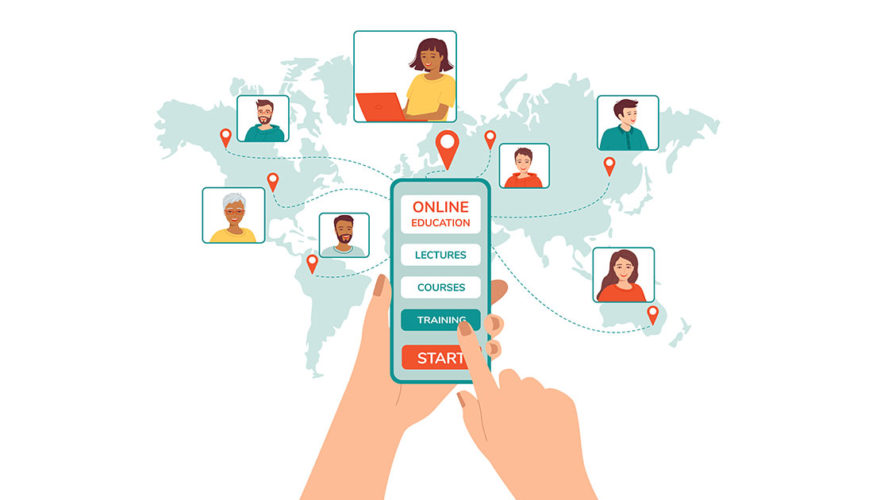With in-person instruction resuming in an ongoing pandemic environment, our expert panel examines the key ways to utilize edtech to engage students both in the classroom and from afar.

Pat Bhava
Founder and CEO, PikMyKid
What is the biggest challenge you see educators facing today?
Closing the learning-loss gap caused by the pandemic. The last two years have forced schools to tackle staffing shortages, hybrid learning, safety scares, and declining mental and physical health for students and faculty. At the end of the day, educators should be able to focus their attention on improving learning outcomes, and that’s just not the reality right now.
Even worse, the current burden placed on our educators is simply unsustainable. Without immediate enhancements to our education tools, teaching methods, and administration technology, we’re going to see an emotionally depleted workforce and a cohort of students left behind by the pandemic.
Where have you seen education technology make the biggest impact in helping to overcome these challenges?
There are hundreds of moving parts outside of the classroom that are essential to a successful school day. Districts and schools that are thriving in spite of these challenges have started adopting smart technologies that take care of the mundane stuff so they can focus their efforts toward addressing the bigger problems of learning gaps, emotional health, and other pandemic-related issues facing our children.
Unfortunately, we’re living through a time where teacher shortages, school violence, and contagion can seriously disrupt the normal functioning of a school. The use of technologies in these areas can help reallocate where our educators spend their time.
Where do you see the adoption of education technology headed in the upcoming school year?
School safety is becoming a big concern for school boards. Whether it’s health safety, emergency preparedness, data privacy, or campus security, there’s a growing need to implement tools and policies that protect students.
We’re seeing a growing disconnect between parents and administrators when it comes to the perception of school safety, wherein the parents feel that more could be done at schools to keep our kids safe. And for schools to maintain enrollment numbers, that gap has to be addressed. Ultimately, I think peace of mind for parents will be as much of a technology adoption driver as the actual safety improvements these tools can provide.
Which technologies have you seen make the biggest impact in enhancing student engagement within blended and remote learning environments?
While the video conferencing apps of the world have provided collaborative environments for students at home, that’s really only half the problem. When we’re talking about hybrid learning, one of the biggest obstacles is actually communication with the parent when there are last-minute changes to the school day.
With that, tools that are perhaps more subtly driving student participation are the ones that create more stable learning environments by keeping parents and schools on the same page. If a student doesn’t have to worry about where they’re learning, they’re more equipped to focus on what they’re learning.
What would you recommend for a school or district that wants to invest in edtech but does not know where to start?
Start with your pain points. Which problems does your staff deal with on a daily basis that could be solved or improved with technology? Once you’ve identified your problem areas, do your research and prioritize purchasing solutions based on efficacy and impact. Take recommendations from other schools, and ask every vendor you speak with to provide third-party verified whitepapers or impact analysis reports.
Finally, explore which grant and funding options are out there for your school. Not only will you get a better idea of which new technologies are covered, but your school may be eligible to adopt them for free.

What is the biggest challenge you see educators facing today?
I think mental health and well-being for everyone in education is the biggest challenge to be addressed right now. Many people are leaving the industry due to fatigue and others are feeling pressure to carry the load. There is a reluctance to return to in-person learning, and districts are facing increased responsibilities for the care and well-being of students.
So much of what we need to do is lean into those approaches that worked well during COVID, including the use of technology and innovative strategies for connecting and bringing the school community together. While there is a desire to return to old habits, we need to continue to move forward, creating a sense of community and belonging, and continuing to transform learning environments that energize both students and educators.
Where have you seen education technology make the biggest impact in helping to overcome these challenges?
The technology solutions that facilitate collaboration, connection, and flexibility have made the biggest difference. I don’t believe there is any perfect one-size-fits-all solution or single platform that can address the complex mental health and well-being challenges we’re seeing in the education industry today, for students and educators alike. That said, I do think incorporating a mix of technology solutions that prioritize and support individualized needs is crucial to making progress in this area.
Where do you see the adoption of education technology headed in the upcoming school year?
Going forward, I see edtech enhancements continuing to be adopted by districts and school systems in an iterative manner. Much like the development of new curriculum, we need to approach edtech solutions as tools to be implemented, tested, and analyzed, and then improved upon over time. With any new addition, it takes time to collect data and assess outcomes. Through trials and customization, you can land on the right blend of technology supports that produces positive results for your unique student populations, educators, and district overall.
Additionally, I believe immersive and inclusive technologies — those that support students and staff with unique needs — are a major part of the future of education technology. Edtech solutions that incorporate inclusive components like accessibility features, speech/language support, remote IEP support, mental health counseling/telehealth, social-emotional learning, and kinesthetic learning features into routine curriculum offerings will begin to become the norm in school year 2022-23 and beyond.
Which technologies have you seen make the biggest impact in enhancing student engagement within blended and remote learning environments?
Technologies that allow for participation and inclusion, and provide students with a sense of ownership over their experience, are typically the most successful. In our ChanceLight Education programs, we encourage and empower our educators to embrace creativity and innovation in their instructional methods. We see our educators utilizing tools that facilitate connection in their virtual and blended classrooms, and they’re continuously using new, creative features to keep students engaged, interested, and showing up for their lessons.
What would you recommend for a school or district that wants to invest in edtech but does not know where to start?
My recommendation is simple: Do your research and engage adequate partner resources. Very few schools and districts have been able to navigate the pandemic impact alone. There are several organizations out there that can take the guesswork out of the equation for you. They bring in the infrastructure, necessary technology, and trained staff to make your district successful.
Whether your district needs assistance transitioning to a fully virtual environment, building a successful hybrid curriculum, or needs to deliver remote special education and IEP services, you don’t need to try to figure it out alone. Don’t be afraid to call in the experts who can help you leverage your district resources effectively to best support your students’ needs.

Melinda Gates
Philanthropist, Businesswoman, and Co-Chair, Bill & Melinda Gates Foundation
Where do you see the adoption of education technology headed in the upcoming school year?
The best educators understand that many, many girls especially are interested in STEM subjects — and many, many girls are really good at STEM subjects — but they get interested in them at different times and for different reasons.
For example, because girls don’t always get the same early exposure to STEM that boys do, their interest tends to develop later. And while boys often get into tech through video games, girls are more likely to develop an interest in the subject when they see it as a way to solve real-world problems.
So educators can help by introducing STEM to girls early, bringing these subjects to life, and by telling the girls in their classes, “Hey, I think you’d be good at this.”
What is the biggest challenge you see educators facing today, especially women educators?
The worst thing you can do is put a lot of pressure on yourself to fit in. I know, because I’ve been there. What I learned is that I was much happier — and much more effective as a professional — when I found my own leadership style. My advice to anyone in that position today is this: You will succeed because of who you are, not in spite of it. And in the meantime, surround yourself with people who believe in you and will bring out the best in you.

Matthew Ryan
What is the biggest challenge you see facing educators today?
The four challenges we hear most from educators are: lack of student engagement, distractions and/or reduced student focus, inadequate educator training relating to how to use and teach new technology, and isolation and/or declining collaboration.
Where have you seen education technology make the biggest impact in helping to overcome these challenges?
Accessibility. The landscape shifted when we faced the pandemic and it sped up technological advancements in education technology. It also forced companies like ours to create virtual and hybrid products. We began offering new learning experiences for schools and students.
For example, we were able to do a virtual STEM field trip for a school in New Mexico, showcasing one of our state-of-the-art wind tunnels. The closest physical iFLY location was several hundred miles away. By creating new technological products, we created more accessibility, opening the door for students to experience something that was not previously possible.
Where do you see the adoption of education technology headed in the upcoming school year?
I see educators looking for ways to escape the classroom and increase student engagement through immersive learning and technology.
Our expertise is working with educators to introduce new technology to students. Students work with our state-of-the-art wind tunnel where they predict, observe, and calculate how objects fly. Then students fly and become the experiment themselves. This is where you can visibly see students connect curriculum with the experience, feeling how force and motion (and other physical science concepts) impact how one flies.
Which technologies have you seen make the biggest impact in enhancing student engagement within blended and remote learning environments?
I think internet speed and accessibility, cheaper hardware, and video conferencing saved the day when the pandemic hit. Had the pandemic occurred many years earlier, I’m not sure we would have been technologically ready. As much as we hear educators mention students are “Zoomed out,” it did allow school districts to continue operations during unprecedented times.
It has also allowed our company to offer virtual and hybrid events, where our internal STEM educators can guide students through our curated curriculum, which is aligned with all state teaching standards.
What would you recommend for a school district that wants to invest in edtech but does not know where to start?
Classroom technology is scaling rapidly and becoming more affordable for school districts. In some instances, we see edtech outpacing educator usability. It is critical educators receive continuous training, so technology can be employed to increase student accessibility and engagement, rather than heighten isolation and suppress teamwork.
In addition, we believe in providing students with immersive learning experiences, whether that’s doing robotics in the classroom, visiting a science museum, or taking a field trip to iFLY. Allow students the opportunity to experience and use real-world applications. We consider it the greatest way to increase student engagement.

